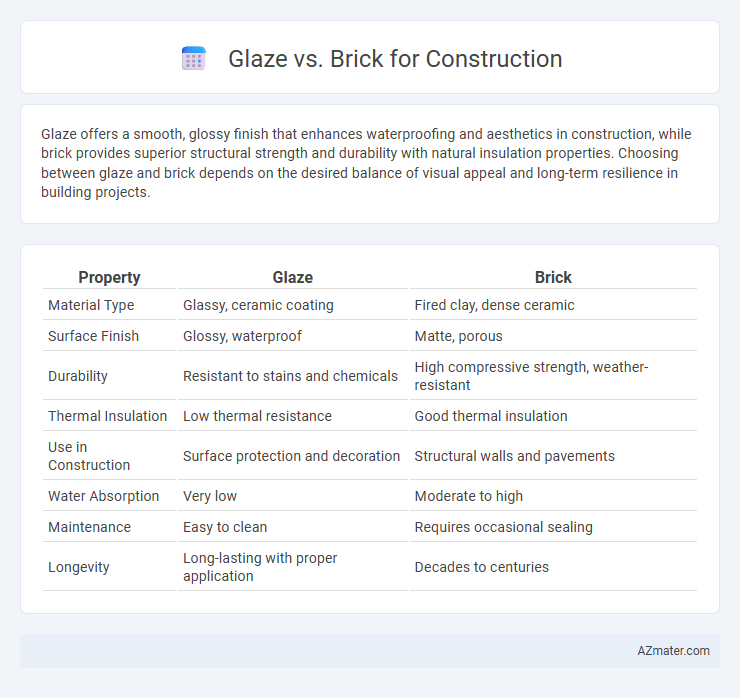Glaze offers a smooth, glossy finish that enhances waterproofing and aesthetics in construction, while brick provides superior structural strength and durability with natural insulation properties. Choosing between glaze and brick depends on the desired balance of visual appeal and long-term resilience in building projects.
Table of Comparison
| Property | Glaze | Brick |
|---|---|---|
| Material Type | Glassy, ceramic coating | Fired clay, dense ceramic |
| Surface Finish | Glossy, waterproof | Matte, porous |
| Durability | Resistant to stains and chemicals | High compressive strength, weather-resistant |
| Thermal Insulation | Low thermal resistance | Good thermal insulation |
| Use in Construction | Surface protection and decoration | Structural walls and pavements |
| Water Absorption | Very low | Moderate to high |
| Maintenance | Easy to clean | Requires occasional sealing |
| Longevity | Long-lasting with proper application | Decades to centuries |
Understanding Glaze and Brick in Construction
Glaze in construction refers to a glassy coating applied to surfaces, enhancing durability and aesthetic appeal by providing resistance to moisture and stains. Brick, composed of fired clay or concrete, serves as a fundamental building material known for its strength, thermal properties, and longevity in structural applications. Understanding the properties of glaze and brick is essential for optimizing building performance, combining the protective benefits of glaze with the structural integrity of brick in various construction projects.
Composition and Material Properties
Glaze in construction typically refers to a glassy coating composed of silica, fluxes, and colorants, applied to surfaces for waterproofing and aesthetic enhancement, while brick is a solid masonry unit made primarily of clay or shale fired at high temperatures for strength and durability. Glazed surfaces exhibit high hardness, chemical resistance, and low porosity, whereas bricks provide excellent compressive strength, thermal mass, and weather resistance due to their dense ceramic matrix. The material properties of glaze allow for smooth, impervious finishes ideal for facades and tiles, contrasting with the structural load-bearing capacity and breathability characteristic of brick masonry.
Aesthetic Appeal: Visual Differences
Glaze offers a sleek, glossy finish that enhances modern architectural designs with reflective surfaces and vibrant colors, creating a visually striking appearance. Brick provides a classic, textured look with earthy tones and natural variations, adding warmth and timeless character to structures. The choice between glaze and brick significantly impacts the aesthetic appeal, influencing the overall style and ambiance of the building facade.
Structural Strength and Durability
Glaze finishes on bricks enhance surface water resistance but do not significantly impact the inherent structural strength of brick masonry, which primarily depends on the brick type and mortar quality. Standard fired clay bricks offer high compressive strength, typically ranging from 7 to 100 MPa, making them durable for load-bearing walls, whereas glazed bricks may have similar strength but improved resistance to weathering and chemical exposure. Over time, glazed bricks maintain aesthetic appeal and reduce surface erosion, contributing to longevity, but unglazed bricks with proper sealing can also achieve substantial durability in construction.
Insulation and Energy Efficiency
Glaze materials offer superior thermal insulation properties compared to traditional brick, significantly reducing heat transfer and improving energy efficiency in buildings. High-performance glazed panels incorporate low-emissivity coatings and argon gas fills that enhance insulation and minimize energy loss. In contrast, brick's thermal mass provides gradual temperature regulation but requires supplementary insulation to achieve similar energy efficiency levels.
Cost Comparison: Glaze vs Brick
Glaze surfaces typically incur higher initial costs than traditional brick due to advanced manufacturing and application processes. Brick offers cost-effective durability with lower upfront expenses but may require more maintenance over time, affecting long-term value. Evaluating total installation and maintenance costs reveals that glazed materials can justify higher prices when factoring in aesthetics and weather resistance.
Weather Resistance and Maintenance
Glaze offers superior weather resistance due to its non-porous surface that repels water, reducing the risk of mold, mildew, and freeze-thaw damage commonly seen in brick materials. Brick is more porous, absorbing moisture which can lead to deterioration over time unless properly sealed and maintained. Maintenance of glazed surfaces typically involves simple cleaning to maintain their protective finish, whereas brick requires periodic sealing and repair to prevent weather-related degradation.
Installation Process and Labor Requirements
Glaze installation typically requires specialized labor for applying a protective coating or finishing layer, involving precise techniques like spraying or brushing to ensure uniform coverage and durability; this process is generally quicker but demands skilled workers familiar with chemical handling and surface preparation. Brick installation involves more labor-intensive steps, including laying each individual brick with mortar, aligning courses, and allowing for drying times, which makes it more time-consuming and physically demanding, often requiring masons with experience in masonry work. The labor cost for brick installation tends to be higher due to the manual effort and time required, while glaze application costs primarily depend on the complexity of the surface treatment and the expertise of the applicators.
Environmental Impact and Sustainability
Glaze finishes on bricks create impermeable surfaces that reduce water absorption, potentially increasing runoff and heat retention in urban environments, impacting local microclimates and stormwater management. Brick materials themselves are highly durable and recyclable, with natural thermal mass properties that contribute to energy efficiency in buildings by regulating indoor temperature fluctuations. Sustainable construction favors unglazed or minimally glazed bricks sourced locally to minimize carbon footprint while maximizing the environmental benefits of natural clay materials.
Best Applications: Choosing Between Glaze and Brick
Glaze offers superior waterproofing and aesthetic appeal, making it ideal for modern commercial buildings and facades requiring sleek finishes and ease of maintenance. Brick provides excellent durability, thermal insulation, and structural strength, best suited for residential homes, traditional architecture, and load-bearing walls. Selecting between glaze and brick depends on project requirements such as weather resistance, design preferences, and building performance standards.

Infographic: Glaze vs Brick for Construction
 azmater.com
azmater.com